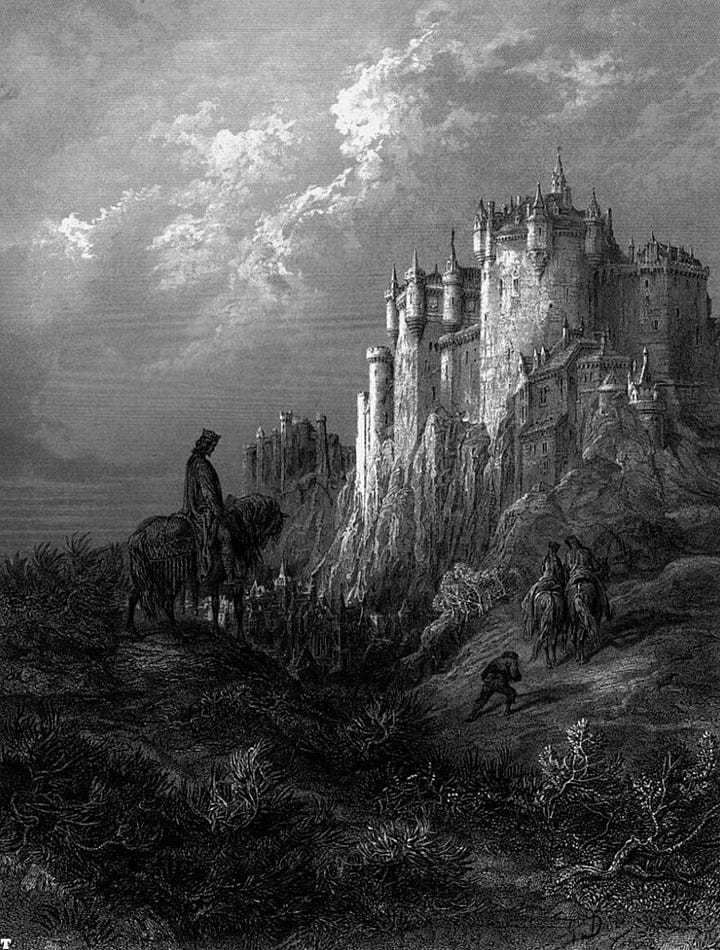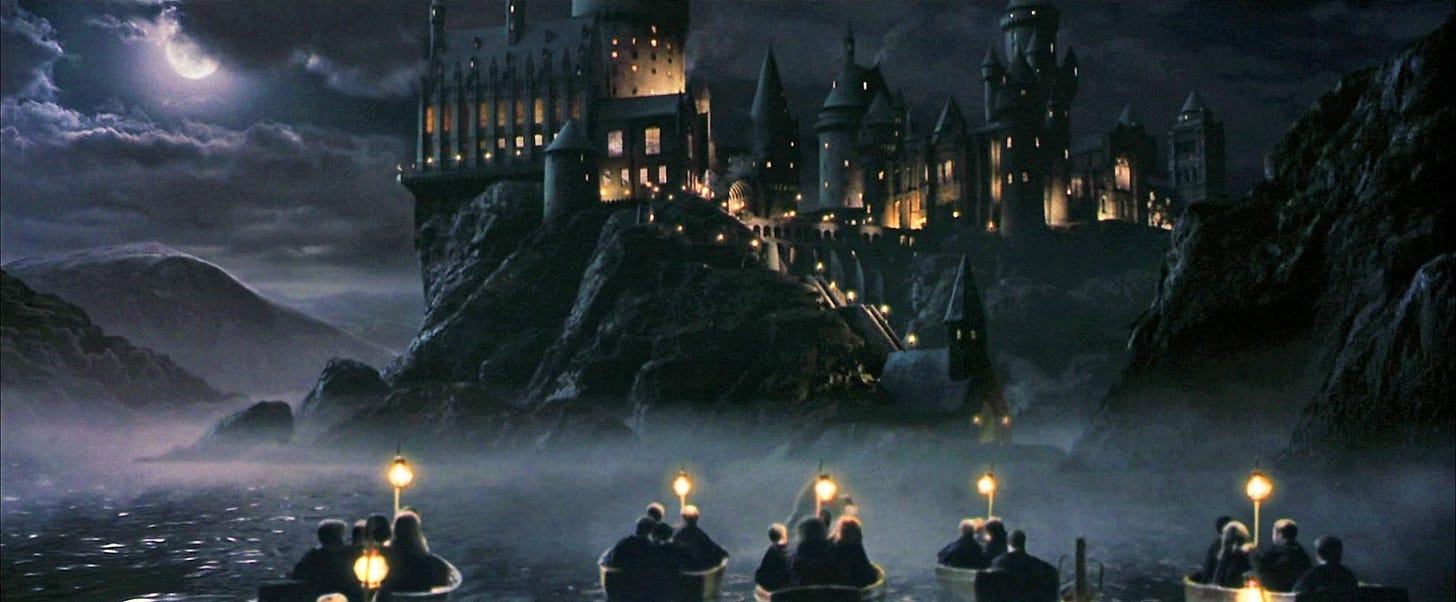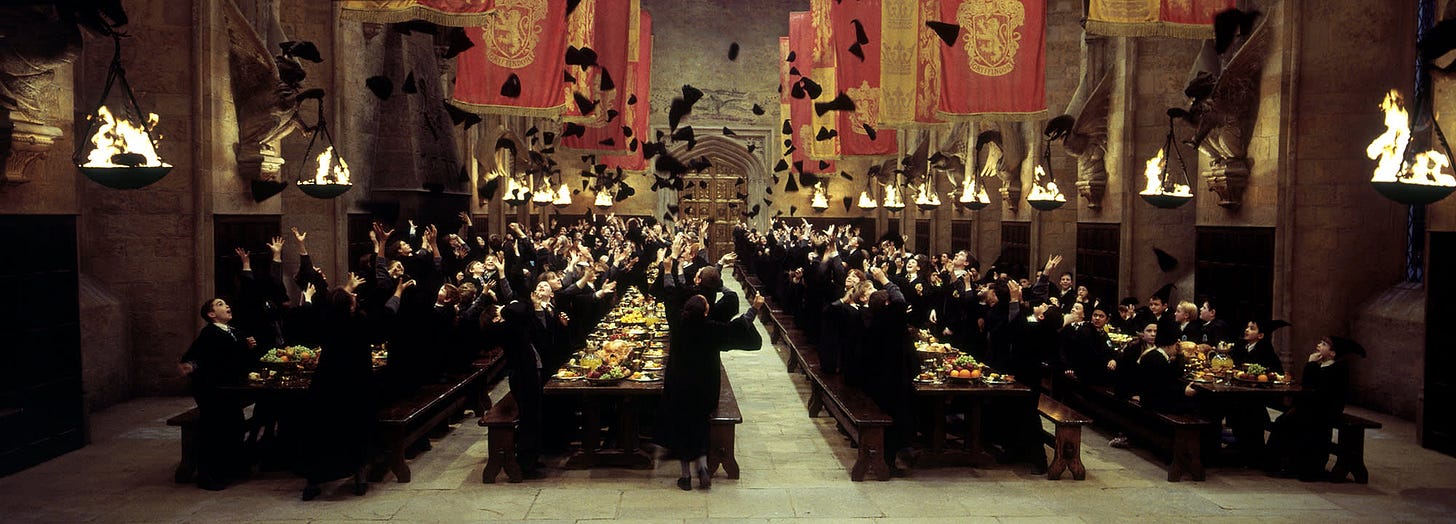I. THE CASTLE
Part I of this series, which started to uncover the spiritual history of Britain hidden within the Harry Potter series, began an exploration of the resonances between the wizarding world and the Anglo-Saxon epics.
We discussed the parallels between incantational magic, the Christian notion of the Word - Logos, and the Anglo-Saxon virtue of treowþ:
This correspondence between word and action also has deep parallels with a particularly English idea: the Anglo-Saxon ideal of treowþ: a precursor to our word truth, which articulates not ‘factualty’ but faith and loyalty. The word of the man of treowþ is his bond, and his actions must reflect his speech. To give your word is to enter into a covenant: you say what you do, and you do what you say. Speech and action, word and motion, are inextricably linked.
But the relationship runs deeper.
There’s something strange about the success of Rowling’s creation: unlike almost every other literary phenomenon, hers is not due to her creation of compelling characters, but to the creation of an irresistible place: Hogwarts.
Every child of a generation yearned to receive the letter which summoned them to the school. Isn’t this odd, when one thinks about it? How is it that a school was able to endow the entire world-feel of the universe with a quiet, beneficent, living energy? What hidden dimension of the British psyche does this represent, and from whence does the idea draw its power?
Hogwarts is an avatar of a much older Anglo belief: that freedom can only be provided by the virtuous king.


The narrow path had opened suddenly on the edge of a great black lake. Perched atop a high mountain on the other side, its windows sparkling in the starry sky, was a vast castle with many turrets and towers…
And the fleet of little boats moved off all at once, gliding across the lake, which was as smooth as glass. Everyone was silent, staring up at the great castle overhead. It towered over them as they sailed nearer and nearer to the cliff on which it stood.
— J. K. Rowling, Harry Potter and the Philosopher’s Stone
Hogwarts is first described as a castle. English epics, from the Arthurian myths to Lord of the Rings, all share a common motif: the hall of the king as shelter from Britain’s enchanted wilderness.
In the Beowulf narrative, the great hall of Heorot, home of the good King Hrothgar, is the lone beacon of the goodness, warmth, and order of civilization. It is the vessel for the protection of the generations of men and for the inheritance of divine knowledge.
Doesn’t the following passage about Heorot’s origins evoke the same sense of warmth and mystery as that of Rowling’s magical school?
Then it came into his heart that he would command men to fashion a hall and a mansion, a mightier house for their mead-drinking than the children of men had ever known, and there-within would he apportion all things to young and old such as God had granted him…
There was the sound of harp and the clear singing of the minstrel; there spake he that had knowledge to unfold from far-off days the first beginning of men, telling how the Almighty wrought the earth, a vale of bright loveliness that the waters encircle; how triumphant He set the radiance of the sun and moon as a light for the dwellers in the lands, and adorned the regions of the world with boughs and with leaves, life too he devised for every kind that moves and lives. Even thus did the men of that company live in mirth and happiness, until one began to work deeds of wrong, a fiend of hell.
— Beowulf (trans. J. R. R. Tolkien)
Some parallels to the Potter-world are obvious, but some are more subtle. Heorot is the Old English word for ‘stag’, a symbol always associated with royalty, and one that is raised atop the standard in the royal cenotaph of Sutton Hoo - the greatest of the Anglo-Saxon burial sites.
The stag is also, of course, the symbol of Harry Potter and of his pure-blood father James before him, indicative of a royal lineage. I will expand on this soon: the importance of the symbology of the bestiary will be a major theme in the next part of this series.
The motif of the warmth of the great hall is inherited by the Arthurian universe, expressed in that place whose name will always live on in the English consciousness: Camelot.
It was Christmas at Camelot – King Arthur’s court,
where the great and the good of the land had gathered,
all the righteous lords of the ranks of the Round Table
quite properly carousing and revelling in pleasure.Time after time, in tournaments of joust,
they had lunged at each other with levelled lances
then returned to the castle to carry on their carolling,
for the feasting lasted a full fortnight and one day,
with more food and drink than a fellow could dream of.The hubbub of their humour was heavenly to hear:
pleasant dialogue by day and dancing after dusk,
so the house and its hall were lit with happiness
and lords and ladies were luminous with joy.— Sir Gawain and the Green Knight (trans. Simon Armitage)
Camelot is the ideal city: the English Jerusalem made possible by the chivalric perfection of its knights. Arthur’s court is where knights learn courtesy: the expression of Christlike virtues.
Unlike the Mediterranean ideal, the British understanding of cyclical history does not have an artistic civilizational summer as its zenith. The Englishman dreams of the perfect shelter from the cold - part Valhalla, part Jerusalem.
But heaven on earth will never be achieved before the Lord comes again. Good times create weak men; comfortable castles create sinful knights. The earthly perfection of Heurot, Camelot, and Hogwarts each prove to be a mirage: their fragile peace is always shattered by one who comes in from the wilderness.
When the Green Knight - a giant being of inhuman color - enters Camelot uninvited, the growing pride and cowardice of the Arthurian knights is exposed. The Christian faith might have established itself, but it can never get too comfortable, lest the fey powers (fairie, untamed, enchanted, other, sinister) of Old England re-assert themselves. The Green Knight bears not a sword but a wand of holly.
Gawain (like Harry, an obscure and humble hero) is the only remaining knight of sufficient virtue to accept the Green Knight’s challenge. Wearing red - symbolizing royalty and the blood of Christ - he goes forth to meet the green giant, whose contrasting color evokes the wild, pagan powers of untamed nature.
This eternal British battle between red and green (fire and nature, spirit and earth, higher and lower) is echoed in the rivalry between Gryffindor and Slytherin: a crusade which attempts to beat back the encroaching paganism (the serpent, human sacrifice, evil magic). The very fact that all these stories have to invoke pagan themes in order to resonate with the British mind is indicative of how tenuous our Christian victory remains.
This symbol of the perfect city has always existed, and perhaps always will. But it was not clear how to make it relevant and accessible for our own age - until Rowling found an unlikely avatar: the British boarding school.
II. THE SCHOOL
Boarding school has always been a mechanism by which to unite disparate threads of identity. Men strewn from around the Isles - and indeed the Empire - were sent to boarding school to initiate them into a coherent group consciousness which they could then radiate outwards again.
These institutions were spiritual endeavors, ever since St. Augustine of Canterbury founded his monasterial school in 597 AD. To this day, education continues on those grounds, with King’s School Canterbury having a claim to being the oldest in the world.
Throughout medieval times, British boys were sent off to noble households and monasteries to learn the higher arts of Latin and theology. Oxford and Cambridge went on to initiate their students into a spiritual existence. The medieval fascinations in Harry Potter, of course, run strong. He learns Potions, Transfiguration, and Defense Against the Dark Arts.
What is it about Hogwarts that proved so deeply attractive to a generation? As Gladstone said of Oxford: “It inculcated a reverence for what was ancient, and free, and great.” Hogwarts, the ancient school, gives the sense to the young reader that they have a history. Harry reads directly from ancient texts. The ongoing truth and relevance of these texts is clear: their magic works.
Unlike in modern schooling, there is no intervening army of ‘muggle’ schoolmarms (ie. non-believers in ancient truths and ways of being). Instead, the children are surrounded by their own ancestors, who fly through the castle as ghosts, or beam at them from moving portraits. There is a living connection with history, uninterrupted by our century of atheism and cynicism.
Rowling’s school does not cater to an individual’s ‘identity’, whatever modern contrivance they might have have adopted, or whatever Muggle background they come from. The student must lose himself in the school and its being. It stands, unapologetic and unmoving in its eternal identity - its otherness - inviting students into a world that is undeniably superior.
It also unapologetically hands its students power. It does not teach them to be cogs in a bureaucratic machine - the skills it imparts would be useless in this regard. No: this is an education for kings and priests. The message of Hogwarts is clear and quintessentially aristocratic: there must be an elevated class, set apart from the hoi polloi, the muggles, and from middle class drudgery, free to pursue intellectual endeavors, ritual, beauty, and to explore the mysteries of reality and history.
The school represents a resolution between the cyclical understanding of history of the pagans and the linear understanding of the Christians, in that it has a beginning but no apparent end. Its stone feels weighty and immovable, reassuring in its permanence. The spirit of Britain can fail but Hogwarts will always be there. The ancient connection remains.
The world is dusty and dirty and crooked and shabby - in a word, old. It is made of natural materials. Its wonkiness and crookedness emphasizes how much of the world is made of old wood and stone, indicative of the closeness of the land itself. The fact that the wizards who inhabit this world are happy to inhabit a dark and crumbling environment is in fact a consolation: it is an indication that their minds rest on higher things than polish, that they are unobsessed with the material.
Rowling makes the monastic allegory explicit in the Deathly Hallows when she tells of the “little church whose stained-glass windows were glowing jewel-bright” and the Christmas carols which “grew louder as they approached the church. It made Harry’s throat constrict, it reminded him so forcefully of Hogwarts.”
The school gives children a sense that although they will face great challenges, the world is fundamentally a place filled with warmth and goodness that they should voyage out into with confidence and wonder.
“Help will always be given at Hogwarts to those who ask for it.”
Hogwarts is a safe place: a place of respite from the demonic forces of the British wilderness. And here we return to the archetypical form of the great hall of the good king with which we began this essay.
III. FREEDOM
If we move back another two centuries to German, Dutch, French and Italian visitors who came to England between 1497 and 1600, they again remarked on the strangeness of England. Though they concentrated on physical manifestations of the differences, they also noted curious English habits such as sending children away from their homes, never to return. The independence, individuality and freedom of the English were also discussed.
- Alan MacFarlane, The Origins of English Individualism: Some Surprises
Hogwarts ultimately represents freedom. A place where the adults are only notionally in charge. In a school of hundreds of students, there are so few teachers that they can sit around a single table. They give wisdom - and sometimes love - but rarely orders, and even then, these orders are never followed. The children roam free. In accordance with the strange English tradition, the young are sent away and are expected to fend for themselves.
This is only possible because Hogwarts is an avatar of the old English ideal of the beneficent land made free by the stewardship of the good king. Each part of this ideal is interrelated: only virtuous men are capable of self-rule.
Any centralizing power is viewed with great suspicion, while fierce loyalty to one’s friends remains. All the villains of the Harry Potter world are those that threaten the sovereignty of the virtuous nobleman: the tyrannical Voldemort, the bureaucratic Ministry of Magic, the prying muggles.
Centralization has always been hated by the Anglo-Saxons. The ancient Germanic pact was that if a man accepted the ultimate spiritual authority of his king, he would be left alone in his own castle to rule. These were the decedents of the Germanic people whom Tacitus noted would conduct no business except with a weapon at their side. You’ll note that the students always have wands at their side - they are ‘always armed’.
That children survive in this anarchic environment is only possible because Hogwarts is also the court of the good king. Dumbledore is the Anglo-Saxon ideal of the king with the light touch - whose outstanding virtue and ability to ‘work miracles’ means that he never needs to assert or impose his sovereignty. His followers are loyal to the death entirely through choice. This is in contrast to Voldemort, who is willing to murder his brothers in the pursuit of power, a terrible sin in the eyes of the Germanics.
While the muggles live in suburbs - we see one house after the next packed together - the wizard houses we see, the Malfoy’s, the Weasely’s, the Lovegood’s, are all independent and remote dwellings, explosions of life amid a cold wilderness. Even Hagrid’s hut is set apart, in which he is able to keep dangerous and illicit animals of his choosing.
The Anglo must stand alone.
I hope that you have enjoyed this essay. Please do leave a like and comment. Part III will follow shortly.
If you appreciate my contributions and would like to support this project, please consider gifting a Becoming Noble subscription. It means a huge amount.
You can also become an ‘enhanced supporter’ if you want to support at more than the minimum amount.
You are all greatly appreciated.
Sic transit imperium,
Johann







I remember starting Harry Potter when I was around 13 or 14, just after finishing The Lord of the Rings, while on holiday in Ireland visiting my grandparents. I recall feeling this deep sense of yearning—for a school and a culture that embodied continuity, that was confident in itself, that was refreshingly hierarchical, and that seamlessly wove our cultural identity into the rhythm of daily life.
You’ve managed to articulate what I couldn’t at the time, and you’ve also done something else much needed lately—you’ve cast the Anglo in a positive light again. That alone feels like an achievement worth celebrating.
This is a wonderfully illuminating essay but, having been at boarding school from the age of 8, although acknowledging the value of the necessary development of the individual the separation from and lack of parental nurture leaves a permanent gap in the makeup.